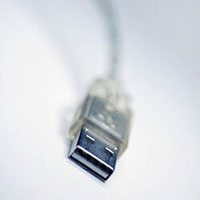By Tripp Lite 107

Tripp-Lite's USB cables come in a variety of models, including USB 1.1, USB 2.0, USB 3.0, USB 3.1 Gen 1, and USB 3.1 Gen 2.
Understanding USB: Speed, Connectors, and Functionality
When the USB connector first came on the market, it was revolutionary in that it replaced a collection of confusing connector types such as serial ports, parallel ports, PS/2 connections, and joystick ports, all of which required dedicated hardware and drivers.
The now-ubiquitous USB connector slims down the number of ports required on a computer, paving the way for smaller, lighter and more portable devices. It simplifies development of new products and improves speed to market. And life is easier for consumers when they do not need a drawer full of cables to connect various peripherals and devices.
However, as USB protocol has evolved, it has become confusing in its own way. The elements distinguishing USB standards are speed, connector types, and added functionality.
USB Speed Standards
USB connections are about to become faster. Products compatible with the new USB 3.1 Gen 2 standard will start to hit the market soon. This latest generation promises to take connectivity to the next level, with data transfer rates twice as fast as USB 3.0 (also known as USB 3.1 Gen 1):
| USB Standard | Data Transfer Speed | Also Known As |
|---|---|---|
| USB 1.1 | 12 Mbps | Full-Speed |
| USB 2.0 | 480 Mbps | Hi-Speed |
| USB 3.0 | 5 Gbps | SuperSpeed |
| USB 3.1 Gen 1 | 5 Gbps | SuperSpeed |
| USB 3.1 Gen 2 | 10 Gbps | SuperSpeed+ or SuperSpeed 10 |
USB Connector Standards
USB Type-A
The standard, universal connector found on virtually every desktop PC and laptop in use today, as well as TVs, game consoles, and media players. Although USB 3.0 Type-A connectors have more internal pins, the form factor is the same, so it can operate in any Type-A port, even USB 1.1. Data transfer, however, will be at the speed of the older generation.
USB Type-B
Most commonly used to connect printers and external hard drives to desktop computers, the Type-B port actually has two different configurations. One is specific to USB 1.1 and 2.0 speed protocols, while the other is for use with the USB 3.0 and later spec.
USB Mini-B
The Mini-B connection is most often used by portable electronics such as digital cameras, MP3 players, and some cell phones, and only with USB 1.1 and 2.0 speeds. There are both four-pin and five-pin versions of the Mini-B connector.
USB Micro-B
The Micro-B connector has one configuration for USB 2.0 and a different configuration for USB 3.0 and later. The Micro-B connector is found on many popular models of Android™ smartphones and external hard drives.
USB Type-C
Developed to support devices with a smaller, thinner and lighter form factor. Type-C is slim enough for a smartphone or tablet, yet robust enough for a desktop computer. It also has the advantage of a reversible plug orientation and cable direction, eliminating the guesswork about which direction the connection goes.
USB Functionality
On the most basic level, USB standards simply let a host, such as a computer or tablet, communicate with peripherals and other devices. But as specifications evolve, USB has become more than a mere data interface. Below are the latest USB functions available on many of today's devices. A device may support one or more of these functions:
Power Delivery
Up to 100 W of power can be delivered across a single USB cable, eliminating the need for a separate power brick. This is especially useful for peripherals that draw higher power levels, such as hard drives and printers. Not all devices will support USB Power Delivery, however; consult the device's specifications chart or owner's manual if uncertain.
Battery Charging 1.2
This USB function can be useful for recharging a phones battery from a USB port. The BC 1.2 spec defines a new type of port, the charging port, that meets standards to ensure a battery will recharge safely and consistently. It also allows a device to pull more power than a standard USB port for faster charging. A normal USB 2.0 port provides up to 500 mA (0.5 A) and a USB 3.0 port provides up to 900 mA (0.9 A). The output of a BC 1.2-compliant port puts out up to 1.5 A, even while transferring data. It also allows the device being charged to communicate its charging requirements to the USB charger, ensuring an optimal charge.
USB On-the-Go
USB OTG allows mobile devices such as a smartphone or tablet to act as a host to other USB devices such as flash drives, keyboards, and mice. With USB OTG, a mobile device can utilize the functionality of the peripherals while still being able to connect to a computer and present itself as a mass storage device to be used on the computer. USB OTG-compliant devices will require an OTG adapter to allow for the connection of peripherals.
DisplayPort Alt Mode
With DisplayPort Alt Mode, USB-C connectors and cables have the ability to transmit both USB data and VGA, DVI, HDMI, or DisplayPort video and/or audio. Adapters are available to connect DisplayPort over USB-C to VGA, DVI, HDMI, and DisplayPort monitors. DisplayPort Alt Mode does not require the use of drivers, making it plug-and-play.